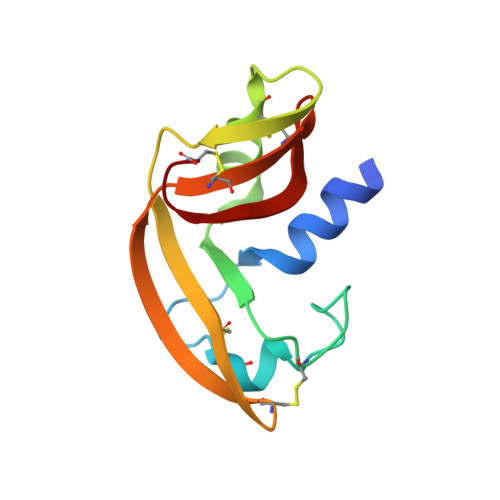Enzymatic and Structural Characterisation of Amphinase, a Novel Cytotoxic Ribonuclease from Rana pipiens Oocytes.
Singh, U.P., Ardelt, W., Saxena, S.K., Holloway, D.E., Vidunas, E., Lee, H.S., Saxena, A., Shogen, K., Acharya, K.R.(2007) J Mol Biol 371: 93-111
- PubMed: 17560606
- DOI: https://doi.org/10.1016/j.jmb.2007.04.071
- Primary Citation of Related Structures:
2P6Z, 2P7S - PubMed Abstract:
Besides Onconase (ONC) and its V11/N20/R103-variant, oocytes of the Northern Leopard frog (Rana pipiens) contain another homologue of ribonuclease A, which we named Amphinase (Amph). Four variants (Amph-1-4) were isolated and sequenced, each 114 amino acid residues in length and N-glycosylated at two positions. Sequence identities (a) among the variants and (b) versus ONC are 86.8-99.1% and 38.2-40.0%, respectively. When compared with other amphibian ribonucleases, a typical pattern of cysteine residues is evident but the N-terminal pyroglutamate residue is replaced by a six-residue extension. Amph variants have relatively weak ribonucleolytic activity that is insensitive to human ribonuclease inhibitor protein (RI). Values of k(cat)/K(M) with hypersensitive fluorogenic substrates are 10(4) and 10(2)-fold lower than the maximum values exhibited by ribonuclease A and ONC, respectively, and there is little cytosine/uracil or adenine/guanine discrimination at the B(1) or B(2) subsites, respectively. Amph variants have cytotoxic activity toward A-253 carcinoma cells that requires intact ribonucleolytic activity. The glycan component has little or no influence over single-stranded RNA cleavage, RI evasion or cytotoxicity. The crystal structures of natural and recombinant Amph-2 (determined at 1.8 and 1.9 A resolution, respectively) reveal that the N terminus is unlikely to play a catalytic role (but an unusual alpha2-beta1 loop may do so) and the B(2) subsite is rudimentary. At the active site, structural features that may contribute to the enzyme's low ribonucleolytic activity are the fixture of Lys14 in an obstructive position, the accompanying ejection of Lys42, and a lack of constraints on the conformations of Lys42 and His107.
Organizational Affiliation:
Department of Biology and Biochemistry, University of Bath, Claverton Down, Bath BA2 7AY, UK.

















